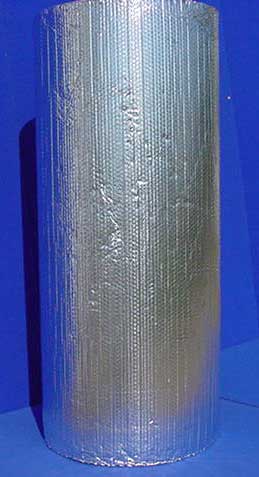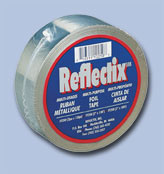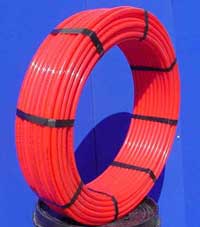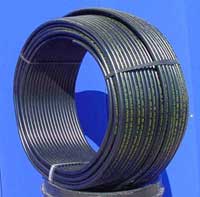Radiant Root

 Greenhouses have several problems when it involves heating them efficiently:
Greenhouses have several problems when it involves heating them efficiently:
- High heat loss
- High heat demand
- High-energy cost
A.I.M. can solve all your heating problems. We stock the most complete inventory of Radiant Greenhouse heating products on the market today. All of our products are designed for easy, do-it-yourself installation.
High heat loss: 25% of your heat loss is downwards. If you insulated under your slab or soil on the floor, you could save 25 % of your heating cost.
Remember: opposites attract!
The typical ground temperature is 55 degrees Fahrenheit. If you attempt to heat your Greenhouse to 75 degrees, you must first compensate for this 20 degree difference through either heat or insulation in order to get the desired temperature. Further, your side walls present the same problem.
A.I.M. sells a fabulous insulation product. Similar to bubble wrap (but significantly stronger), it consists of foil on both sides to reflect the radiant heat, and can tolerate both water and moisture.
Available 4 wide X 125 long $ 210.00
High heat demand: The average greenhouse today is heated by hot air. With this conventional method, you must heat the entire volume of your space before you get the desired temperature where your plants are located.
Remember: Hot air rises--radiant heat does not .
The sun's rays are radiant; traveling in any direction when reflected by a mirror or foil, just like radiant heat. Placing radiant tubing with a set point sensor in the floor over foil insulation, you can maintain a desired temperature within 1 degree at the roots of your plants. When placed on the floor, the temperature at the ceiling can be 10-20 degrees more. You are concerned with the temperature at the plant location; not the void above.
A.I.M. sells two types of radiant floor tubing. Both types are cross-linked Pex with an oxygen diffusion barrier. Why this barrier so critical? The oxygen diffusion barrier prevents oxygen from permeating into the water in the tubing, thereby traveling to the boiler and rusting it from the inside out. Also, other parts in your system, such as circulators and valves will last you much longer. Standard Pex Tubing is used in concrete slab installations: Maximum loop length is important.
All prices are per ft. Sold in full coil length only.
For concrete installation
3/8" Standard Pex Tubing 300 and 600
1/2" Standard Pex Tubing 300 and 600
5/8" Standard Pex Tubing 600
3/4" Standard Pex Tubing 500
1" Standard Pex Tubing 100 and 500
For soil and gravel installation
3/8" Pex Al Pex Tubing 600
1/2" Pex Al Pex Tubing 600
5/8" Pex Al Pex Tubing 500
Pex AL Pex Tubing is the premiere type of radiant heat tubing. The difference is the aluminum wrapped around the standard Pex, extruded and welded across the entire length. Then another layer of Pex is added to protect the aluminum from abrasions. The aluminum passes the water temperature much faster to the soil around it. This is a critical factor with soil heating, though not as important with concrete installations.
Estimating Greenhouse Material For Radiant Heating:
Example:
Greenhouse dimension 30 X 100 = 3000 sq.ft. 3000 X 1.5 = 4500 Tubing installed on 9" spacing.
4500 ft." Standard Radiant Tubing installed in concrete with insulation underneath will produce 30 Btu/h per ft. of Tubing, 4500 X 30 = 135,000 Btu/h
Material Needed for this Greenhouse: Package # 1
| Qty | Description | SKU | Price | Extended Price |
| 1 | Oil Boiler 151,000 | A108 | ||
| 4500 | Tubing | A029 | ||
| 2000 | Pipe Ties | A046 | ||
| 46" | Fitting crimp | V333M | ||
| 46" | Press Ring | V33R | ||
| 2 | Taco Circ. 0011 | A070 | ||
| 2 | Taco Flange set | A078 | ||
| 1 | Air eliminator | A089 | ||
| 1 | 3 way Mix Valve | A101 | ||
| 2 | Flo-Check Valve | A084 | ||
| 1 | Set point Control Gr | 80222 | ||
| Total Cost plus Freight Collect | ||||
Estimating Greenhouse Material
Extra Material Needed for Completing the Installation:
| Qty | Description | Price | Extended Price |
| 46 | 1" Copper 18" long | ||
| 46 | 46 Sweat Ball Valves | ||
| 46 | 1"x 1"x1 " T | ||
| 4 | 1" Elbow Sweat | ||
| 46 | 1" Crimp Fittings | ||
| 30" | 1" Copper Reverse Return | ||
| Total Cost plus Freight Collect: | |||
|
Installing a Waste-Oil Boiler and Burner will be your Fastest Payback Ever: |
Greenhouse Heating Requirements
Heating is a major concern for commercial greenhouse producers. This is due primarily to the costs involved in the purchase and operation of heating equipment as well as the potentially disastrous effects of a poorly designed system. Although solar energy represents a significant factor in greenhouse heating, supplemental systems are a necessity for year-round production.Sources and Methods of Distributing Heat:
Coal, oil and gas are the most common forms of energy used for greenhouse heating. The choice of which to use is based primarily on economics. For example, in Texas gas is the most readily available, as well as economically feasible.
Gas burns efficiently, but all forms must be vented to avoid toxic fumes. Many types of gas heaters have been designed for use in greenhouses and they too effect efficiency. When selecting this type of heating equipment it is important to consider fuel and cost factors.
Heat from gas units may be distributed in several different ways. Perhaps the most common method used is through polyethylene (PE) vent tubes. These PE tubes are generally attached near the heater and are inflated when the blower fan is turned on. The heat is forced through the tube and distributed into the house from holes perforated in the PE. These systems may also be used in combination with ventilation and circulation equipment.
The arrangement of PE tubes in the greenhouse greatly influences efficiency as well as plant growth. When tubes are hung overhead, heat is more likely to move out of the "plant zone" and into the upper portion of the structure. When tubes are placed under the benches efficiency is improved and heat is maintained in the appropriate area for optimum plant growth. This type of tube arrangement requires floor mount heating systems or ducts that move the heat from overhead units to the under bench tubes.
Although boilers and traditional hot water/steam heating systems are not used extensively in this area, there is a variation of these systems that is becoming increasingly popular among Texas growers. The use of hot water for "under pot heating" has been proven to be extremely effective and efficient. In these systems, water is heated in a modified hot water heater and pumped through an extensive tubing system that is mounted to the bench. The heat is radiated from the tubes and is absorbed by the pots that are placed directly on them. The media in the pot is maintained at a constant temperature, which allows air temperatures to be held much lower than with traditional systems. The overall effect is improved plant growth and reduced energy costs.
Thermostats and Controls
There are several types of thermostats and environmental controllers that are available for commercial greenhouse production. Regardless of how sophisticated this equipment is, there are some very basic factors that must be considered if the system is to operate properly.
Sensing devices should be placed at plant level in the greenhouse. Thermostats hung at eye level are easy to read but do not provide the necessary input for optimum environmental control. It is also important to have an appropriate number of sensors throughout the production area. Often times environmental conditions can vary significantly within a small distance.
Do not place thermostats in the direct rays of the sun. This will obviously result in poor readings. Mount thermostat so that they face North or in a protected location. It is also sometimes necessary to use a small fan to pull air over the thermostat to get appropriate values.
Calculating Greenhouse Heating Requirements
The key to efficiently heating a greenhouse is matching the equipment to the types of crops to be produced. The first step in this process is to determine the heat loss of the greenhouse. Based on this information the type and capacity of a system may be selected. The following is a series of formulas which may be used for these calculations:
- Using Figure 1, determine the exposed surface area of the greenhouse covering (i.e. poly, fiberglass, glass, etc.).
- Using Figure 1, determine the exposed surface area of other materials (i.e. concrete block, poured cement, brick, etc.).
- From Table 1, determine the corresponding U value for each of the materials listed in 1 and 2 above.
- Determine the difference between the highest temperature to be maintained in the greenhouse and the minimum outside night temperature where: T = (max inside temp) - (min outside temp)
- Calculate the conduction heat loss factor (QC) for each of the materials listed in 1 and 2 where: QC = Exposed surface area x U x T
- Using Figure 1, calculate the volume of the greenhouse structure (V).
- Using Table 2, calculate the air infiltration heat loss (QA) where: QA = 0.22 x T x V x value from Table 2
- Calculate total greenhouse heat loss (QT) where: QT = QC + QA





